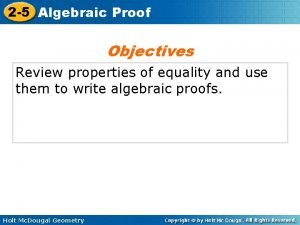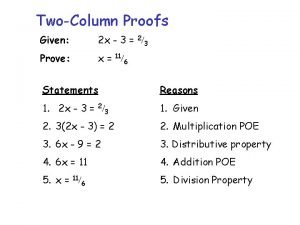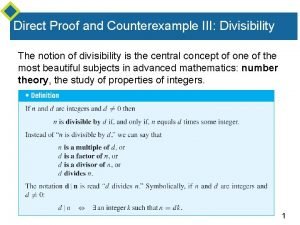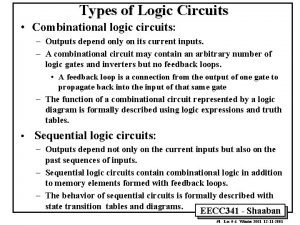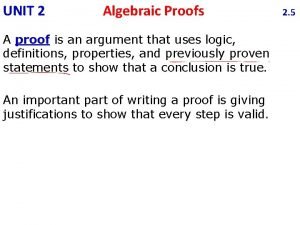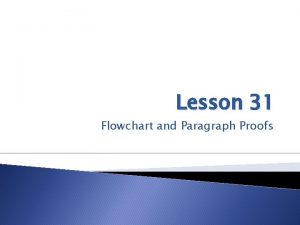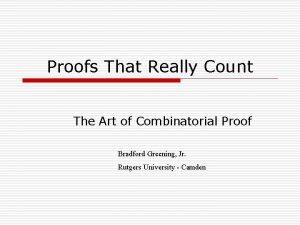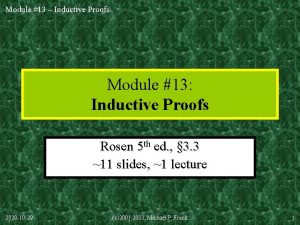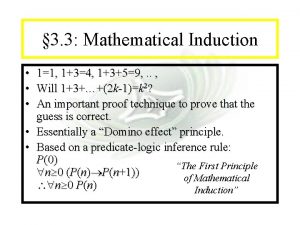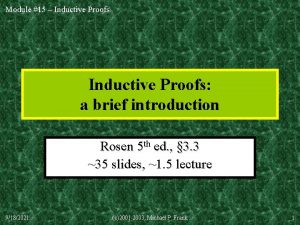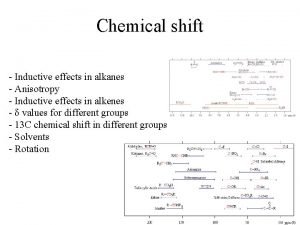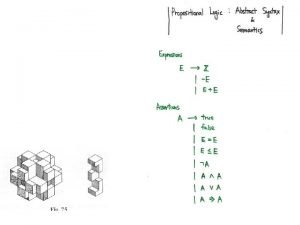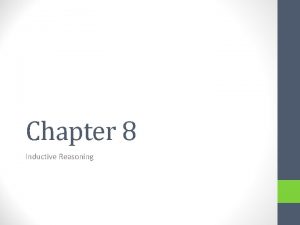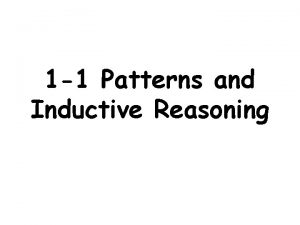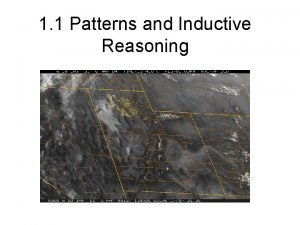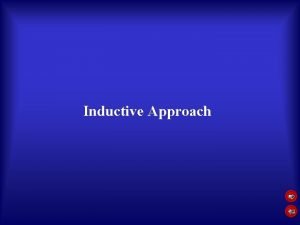Module 13 Inductive Proofs Module 13 Inductive Proofs












- Slides: 12

Module #13 – Inductive Proofs Module #13: Inductive Proofs Rosen 5 th ed. , § 3. 3 ~11 slides, ~1 lecture 2020 -12 -01 (c)2001 -2003, Michael P. Frank 1

Module #13 – Inductive Proofs § 3. 3: Mathematical Induction • A powerful, rigorous technique for proving that a predicate P(n) is true for every natural number n, no matter how large. • Essentially a “domino effect” principle. • Based on a predicate-logic inference rule: P(0) “The First Principle of Mathematical n 0 (P(n) P(n+1)) Induction” n 0 P(n) 2020 -12 -01 (c)2001 -2003, Michael P. Frank 2

Module #13 – Inductive Proofs Validity of Induction Proof that k 0 P(k) is a valid consequent: Given any k 0, n 0 (P(n) P(n+1)) (antecedent 2) trivially implies n 0 (n<k) (P(n) P(n+1)), or (P(0) P(1)) (P(1) P(2)) … (P(k 1) P(k)). Repeatedly applying the hypothetical syllogism rule to adjacent implications k-1 times then gives P(0) P(k); which with P(0) (antecedent #1) and modus ponens gives P(k). Thus k 0 P(k). 2020 -12 -01 (c)2001 -2003, Michael P. Frank 3

Module #13 – Inductive Proofs The Well-Ordering Property • The validity of the inductive inference rule can also be proved using the well-ordering property, which says: – Every non-empty set of non-negative integers has a minimum (smallest) element. – S N : m S : n S : m n • Implies {n| P(n)} has a min. element m, but then P(m-1) P((m-1)+1) contradicted. 2020 -12 -01 (c)2001 -2003, Michael P. Frank 4

Module #13 – Inductive Proofs Outline of an Inductive Proof • Want to prove n P(n)… • Base case (or basis step): Prove P(0). • Inductive step: Prove n P(n) P(n+1). – E. g. use a direct proof: – Let n N, assume P(n). (inductive hypothesis) – Under this assumption, prove P(n+1). • Inductive inference rule then gives n P(n). 2020 -12 -01 (c)2001 -2003, Michael P. Frank 5

Module #13 – Inductive Proofs Generalizing Induction • Can also be used to prove n c P(n) for a given constant c Z, where maybe c 0. – In this circumstance, the base case is to prove P(c) rather than P(0), and the inductive step is to prove n c (P(n) P(n+1)). • Induction can also be used to prove n c P(an) for an arbitrary series {an}. • Can reduce these to the form already shown. 2020 -12 -01 (c)2001 -2003, Michael P. Frank 6

Module #13 – Inductive Proofs Second Principle of Induction • Characterized by another inference rule: P is true in all previous cases P(0) n 0: ( 0 k n P(k)) P(n+1) n 0: P(n) • Difference with 1 st principle is that the inductive step uses the fact that P(k) is true for all smaller k<n+1, not just for k=n. 2020 -12 -01 (c)2001 -2003, Michael P. Frank 7

Module #13 – Inductive Proofs Induction Example (1 st princ. ) • Prove that the sum of the first n odd positive integers is n 2. That is, prove: • Proof by induction. P(n) – Base case: Let n=1. The sum of the first 1 odd positive integer is 1 which equals 12. (Cont…) 2020 -12 -01 (c)2001 -2003, Michael P. Frank 8

Module #13 – Inductive Proofs Example cont. • Inductive step: Prove n 1: P(n) P(n+1). – Let n 1, assume P(n), and prove P(n+1). By inductive hypothesis P(n) 2020 -12 -01 (c)2001 -2003, Michael P. Frank 9

Module #13 – Inductive Proofs Another Induction Example • Prove that n>0, n<2 n. Let P(n)=(n<2 n) – Base case: P(1)=(1<2)=T. – Inductive step: For n>0, prove P(n) P(n+1). • Assuming n<2 n, prove n+1 < 2 n+1. • Note n + 1 < 2 n + 1 (by inductive hypothesis) < 2 n + 2 n (because 1<2=2 20 2 2 n-1= 2 n) = 2 n+1 • So n + 1 < 2 n+1, and we’re done. 2020 -12 -01 (c)2001 -2003, Michael P. Frank 10

Module #13 – Inductive Proofs Example of Second Principle • Show that every n>1 can be written as a product p 1 p 2…ps of some series of s prime numbers. Let P(n)=“n has that property” • Base case: n=2, let s=1, p 1=2. • Inductive step: Let n 2. Assume 2 k n: P(k). Consider n+1. If prime, let s=1, p 1=n+1. Else n+1=ab, where 1<a n and 1<b n. Then a=p 1 p 2…pt and b=q 1 q 2…qu. Then n+1= p 1 p 2…pt q 1 q 2…qu, a product of s=t+u primes. 2020 -12 -01 (c)2001 -2003, Michael P. Frank 11

Module #13 – Inductive Proofs Another 2 nd Principle Example • Prove that every amount of postage of 12 cents or more can be formed using just 4 cent and 5 -cent stamps. • Base case: 12=3(4), 13=2(4)+1(5), 14=1(4)+2(5), 15=3(5), so 12 n 15, P(n). • Inductive step: Let n 15, assume 12 k n P(k). Note 12 n 3 n, so P(n 3), so add a 4 -cent stamp to get postage for n+1. 2020 -12 -01 (c)2001 -2003, Michael P. Frank 12
 Lesson 10 unknown angle proofs
Lesson 10 unknown angle proofs Lesson 9 unknown angle proofs
Lesson 9 unknown angle proofs C device module module 1
C device module module 1 2-5 algebraic proof
2-5 algebraic proof Two column proofs
Two column proofs Proof by counterexample
Proof by counterexample Boolean algebra proofs
Boolean algebra proofs Proving lines parallel
Proving lines parallel Unit 2 homework 6 algebraic proof
Unit 2 homework 6 algebraic proof Proofs with uno
Proofs with uno Flowchart proof example
Flowchart proof example Proofs that really count
Proofs that really count Proofs involving segment congruence
Proofs involving segment congruence



